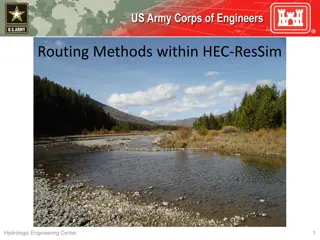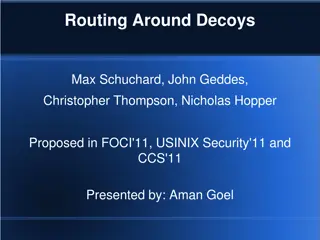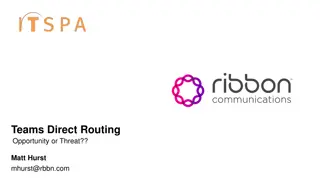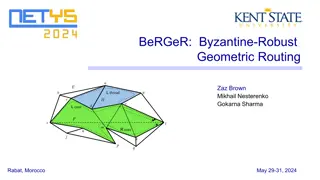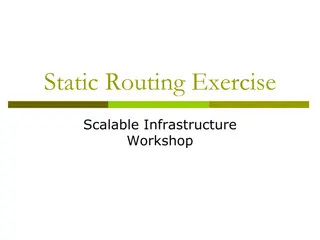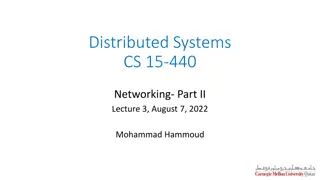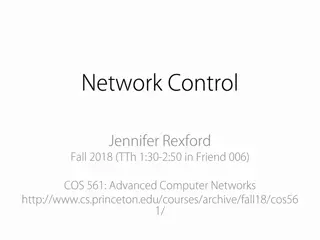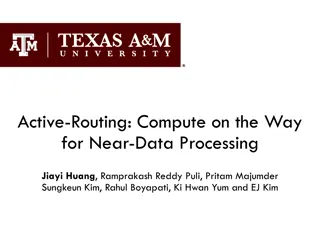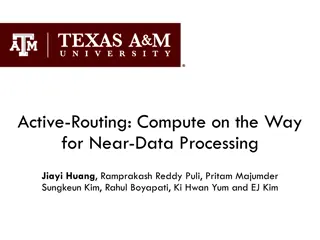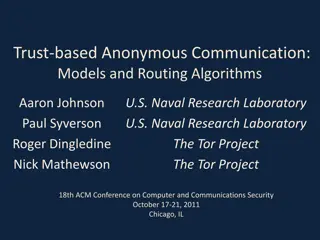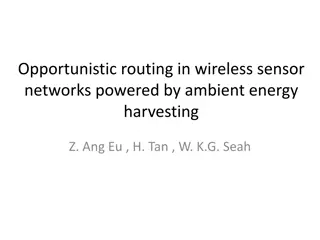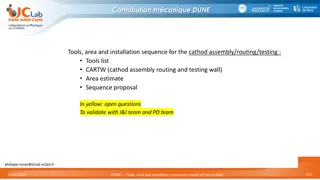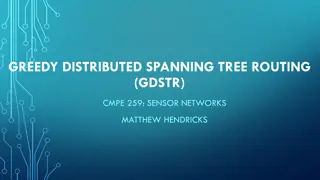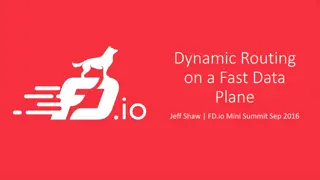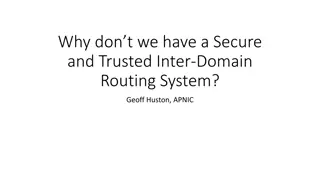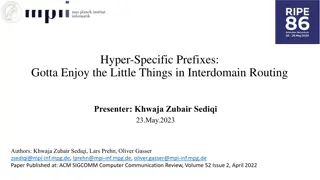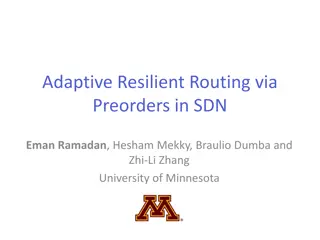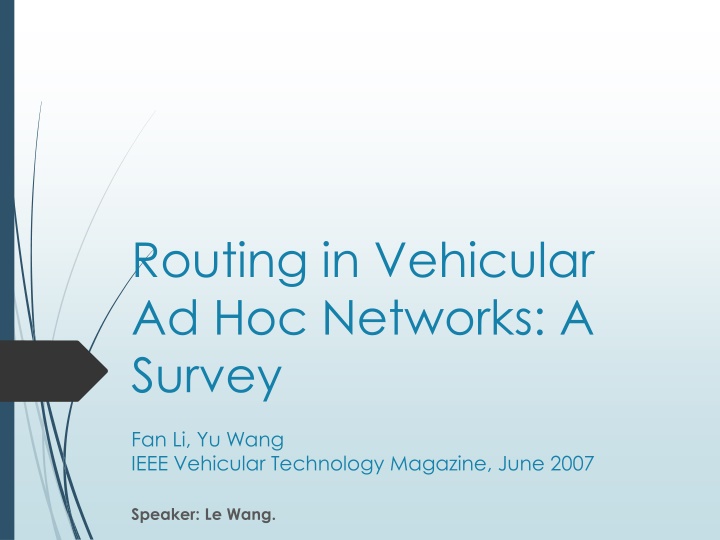
Routing in Vehicular Ad Hoc Networks: A Comprehensive Survey
This comprehensive survey delves into the intricate realm of Routing in Vehicular Ad Hoc Networks (VANETs). The integration of ad hoc networks, wireless LAN, and cellular technology in VANETs presents unique challenges and opportunities for enhancing road traffic safety and efficiency. The paper explores various routing protocols tailored for VANETs, addressing issues such as mobility models and major applications. Additionally, it discusses standards like IEEE 802.11p and protocols such as WAVE for Wireless Access in Vehicular Environments. The ultimate goal is to optimize communication time while conserving network resources, given the distinct characteristics of VANETs compared to Mobile Ad Hoc Networks (MANETs).
Uploaded on | 0 Views
Download Presentation

Please find below an Image/Link to download the presentation.
The content on the website is provided AS IS for your information and personal use only. It may not be sold, licensed, or shared on other websites without obtaining consent from the author. If you encounter any issues during the download, it is possible that the publisher has removed the file from their server.
You are allowed to download the files provided on this website for personal or commercial use, subject to the condition that they are used lawfully. All files are the property of their respective owners.
The content on the website is provided AS IS for your information and personal use only. It may not be sold, licensed, or shared on other websites without obtaining consent from the author.
E N D
Presentation Transcript
Routing in Vehicular Ad Hoc Networks: A Survey Fan Li, Yu Wang IEEE Vehicular Technology Magazine, June 2007 Speaker: Le Wang.
Outline 2 1. Motivation and overview 2. Routing Protocols Ad Hoc Routing Position-Based Routing Cluster-Based Routing Broadcast Routing Geocast Routing 3. Mobility Model 4. Application 5. Summary 3/17/2025
Outline 3 1. Motivation and overview 2. Routing Protocols Ad Hoc Routing Position-Based Routing Cluster-Based Routing Broadcast Routing Geocast Routing 3. Mobility Model 4. Summary 3/17/2025
Motivation 4 Vehicular Ad Hoc Network (VANET): integrates ad hoc network, wireless LAN (WLAN) and cellular technology to achieve intelligent inter-vehicle communications to improve road traffic safety and efficiency Distinguish from other kinds of ad hoc networks: Hybrid network architectures Node movement characteristics New application scenarios 3/17/2025
Major Application 5 Co-operative traffic monitor Control of traffic flows Real-time detour routes computation Blind crossing prevention of collisions Nearby information services Internet connectivity to vehicular nodes while on the move, such as streaming video, email etc. 3/17/2025
Standards 6 The formal 802.11p standard is scheduled to be published in April, 2009 (this is a 2007 paper) IEEE Std 802.11p-2010, now incorporated in IEEE Std 802.11-2012 Use 5.85 5.925 Ghz 75 MHz of sprectrum WAVE: Wireless Access in Vehicular Environments IEEE 1609 protocols suites IEEE 1609.2: Security IEEE 1609.3: Management Control IEEE 1609.4: Multichannel Operation 3/17/2025
Outline 7 1. Motivation and overview 2. Routing Protocols Ad Hoc Routing Position-Based Routing Cluster-Based Routing Broadcast Routing Geocast Routing 3. Mobility Model 4. Summary 3/17/2025
Routing Protocol for VANETs 8 Goal: to achieve minimal communication time with minimum consumption of network resources. The performance of the existing routing protocols developed for MANETs (Mobile Ad Hoc Networks) suffer from poor performance due to: Fast vehicles movement Dynamic information exchange Relative high speed of mobile nodes 3/17/2025
VANET Architectures 9 (a) Vehicular to Infrastructure (V2I) (b) Vehicular to Vehicular (V2V) (c) Hybrid of V2I and V2V 3/17/2025
VANETs Characteristics 10 Highly dynamic topology High speed of movement between vehicles results in topology change. eg: Distance of two cars: 250m; Speed: 60 mph in opposite directions; Link will last only for 10 seconds. Frequently disconnected network The connectivity of the VANETs could be changed frequently. One solution is to pre-deploy several relay nodes or AP along the road to keep the connectivity (V2I). Sufficient energy and storage The nodes have ample energy and power Geographical type of communication VANETs address geographical areas where packets need to be forwarded 3/17/2025
VANETs Characteristics 11 Mobility modelling and predication Mobility model and predication play an important role in VANETs protocol design. Various communications environments In highway traffic scenarios, the environment is simple and straightforward; In city, direct communication is difficult because the streets are often separated by buildings, trees and other obstacles. Hard delay constraints Delay has to be considered; eg: when brake event happens, the message should be transferred and arrived in a certain time to avoid car crash. Interaction with on-board sensors On-board sensors is to provide information which can be used to form communication links and for routing purposes. 3/17/2025
Outline 12 1. Motivation and overview 2. Routing Protocols Ad Hoc Routing Position-Based Routing Cluster-Based Routing Broadcast Routing Geocast Routing 3. Mobility Model 4. Summary 3/17/2025
Ad Hoc Routing 13 AODV, PRAODV, PRAODVM LAR 3/17/2025
Routing: Ad Hoc Routing 14 A.k.a. Topology-based routing Similarities with MANET: not relying on fixed infrastructure; self-organization; self-management; low bandwidth and short radio transmission range. AODV: Ad-hoc On-demand Distance Vector DSR: Dynamic Source Routing Differences from MANET: Highly dynamic topology AODV evaluation PRAODV PRAODVM ZOR and LAR 3/17/2025
Ad Hoc Routing 15 AODV (Ad-hoc On-demand Distance Vector) in VANET: Unable to quickly find, maintain and update long routes in a VANET. TCP is impossible because of the excessive lost of packets. Even when the scalability is not a problem with path lengths of only a few hops, AODV still breaks very quickly due to the dynamic nature. PRAODV and PRAODVM: Prediction-based: predict the link lifetimes. PRAODV builds a new alternate route before the end of the predicted lifetime, while AODV does it when route failure happens. PRAODVM: select the max predicted lifetime instead of selecting the shortest path in AODV and PRAODV Results: Slightly improvement and heavily depend on the accuracy of the prediction method. 3/17/2025
Ad Hoc Routing 16 LAR (location-aided routing): AODV is modified to only forward the route requests within the Zone of Relevance (ZOR). ZOR can be rectangular or circular range determined by the application For example: ZOR covers the region behind the accident on the side of highway where the accident happens. 3/17/2025
Outline 17 1. Motivation and overview 2. Routing Protocols Ad Hoc Routing Position-Based Routing Cluster-Based Routing Broadcast Routing Geocast Routing 3. Mobility Model 4. Application 5. Summary 3/17/2025
Position-based Routing 18 GPSR GSR GPCR A-STAR 3/17/2025
Routing: Position-Based Routing 19 Node movement in VANETs is usually restricted in bidirectional movements Obtaining geographical location information from street maps, GPS is feasible. More promising routing paradigm for VANETs. 3/17/2025
Position-Based Routing: GPSR 20 GPSR (Greedy Perimeter Stateless Routing) Greedy routing always forwards the packet to the node that is geographically closest to the destination. GPSR combines the greedy routing with face routing. Using face routing to get out of the local minimum where greedy routing failed. Suitable for free open space scenario with evenly distributed nodes. 3/17/2025
Position-Based Routing: GPSR 21 GPSR s failure a. The relative neighborhood graph (RNG) is a planar topology used by GPSR. A link uv will exist if the intersection of two circles centered at u and v does not contain any other nodes. b. Link uv is removed by RNG since nodes a and b are inside the intersection of two circles centered at u and v. However, due to obstacles there is no direct link ua or ub. Thus the network is disconnected between u and v 3/17/2025
Position-Based Routing: GSR 22 GSR (Geographic Source Routing) assumes the aid of a street map in city environments. Use Reactive Location Service (RLS) to get the global knowledge of the city topology. Given the above information, the sender determines the junctions that have be traversed by the packet using the Dijkstra s shortest path algorithm. Forwarding between junctions is then done by position-based fashion. 3/17/2025
Position-Based Routing : GPCR 23 GPCR (Greedy Perimeter Coordinator Routing) does not use either source routing (DSR or GSR) or street map. It utilizes the fact that the nodes at a junction follow a natural planar graph. Thus a restricted greedy algorithm can be followed as long as the nodes are in a street. Junctions are the only places where routing decisions are taken. Therefore packets should be forwarded on a junction rather than across the junction. Restricted greedy routing S wants to forward the packet to D. For regular greedy forwarding, the packet will be forwarded to N1, then N3. For greedy routing, the packet will be forwarded to C1, then N2,C2,D. 3/17/2025
Position-Based Routing: GPCR 24 GPCR also uses a repair strategy to get out of the local minimum, i.e., no neighbor exists which is closer to the destination than the intermediate node itself. 1. decides, on each junction, which street the packet should follow next, by right hand rule. 2. applies greedy routing, in between junctions, to reach the next junction. S is the local minimum since no other nodes is closer to the destination D than itself. The packet is routed to C1, which chooses the street that is the next one counter-clock wise from the street the packet has arrived on. The packet is forwarded to C2 through N1. Then C2 forward the packet to N2. Now, the distance from N2 to D is closer than at the beginning of the repair strategy at Node S. GPCR switches back to modified greedy routing. GPCR has higher delivery rate than GPSR with large number of hops and slight increase in latency 3/17/2025
Position-Based Routing : A-STAR 25 Challenge: in a built-up city, vehicles are not evenly distributed; the constrained mobility by the road patterns; difficult signal reception due to radio obstacles such as high-rise buildings may lead VANETs unconnected. A-STAR (Anchor-based Street and Traffic Aware Routing) Use street map to compute the sequence of junctions (anchors) through which a packet must pass to reach the destination. Unique: Use statistically rated maps by counting the number of city bus routes on each street to identify anchor paths. Or use Dynamically rated maps by monitoring the latest traffic condition to identify the best anchor paths. The packet is salvaged by traversing the new anchor path. To prevent other packets from traversing through the same void area, the street is marked as out of service temporarily. Results: A-STAR shows the best performance compared to GSR and GPSR with traffic awareness. 3/17/2025
Outline 26 1. Motivation and overview 2. Routing Protocols Ad Hoc Routing Position-Based Routing Cluster-Based Routing Broadcast Routing Geocast Routing 3. Mobility Model 4. Application 5. Summary 3/17/2025
Cluster-based Routing 27 COIN CORA_CBF 3/17/2025
Routing: Cluster-Based Routing 28 A virtual network infrastructure must be created through the clustering of nodes. Vehicles from multiple clusters in cluster-based routing Each cluster can have a cluster head, which is responsible for intra- and inter-cluster coordination in the network management function. Nodes inside a cluster communicate via direct links. Inter-cluster communication is performed via the cluster- heads. 3/17/2025
Cluster-Based Routing: COIN 29 Current MANETs clustering techniques are unstable in VANET because the clusters are too short-lived to provide scalability with low communications overhead. COIN (Clustering for Open IVC Networks) Cluster head election is based on vehicular dynamics and driver intentions, instead of ID or any classical clustering methods. Accommodate the oscillatory nature of inter-vehicle distances. Results: COIN increases the average cluster lifetime by 192%; reduces number of cluster membership changes by 46%. 3/17/2025
Cluster-Based Routing: LORA_CBF 30 LORA_CBF Process: Each node can be the cluster head, gateway or cluster member. Each cluster has exactly one cluster-head. If a node is connected to more than one cluster, it is called a gateway. The cluster-head maintains members and gateways. If the destination is unavailable, the source will send out the location request (LREQ) packets. information about its It is similar to AODV, but only the cluster heads and gateways will disseminate the LREQ and LREP (Location Reply) messages. Results: performance of AODV and DSR more significantly than LORA_CBF. Network mobility and size affect the 3/17/2025
Cluster-Based Routing 31 Cluster-based routing protocols can achieve good scalability for large networks But a significant hurdle for them in fast-changing VANET systems is a delay and overhead involved in forming and maintaining these clusters. 3/17/2025
Outline 32 1. Motivation and overview 2. Routing Protocols Ad Hoc Routing Position-Based Routing Cluster-Based Routing Broadcast Routing Geocast Routing 3. Mobility Model 4. Application 5. Summary 3/17/2025
Broadcast Routing 33 Flooding BROADCOMM UMB Others 3/17/2025
Routing: Broadcast Routing 34 Broadcast is frequently used in VANET Flooding is the simplest routing way by using broadcast. Advantages: Each node re-broadcasts messages to all of its neighbors except the one it got this message from. Flooding guarantees the message will eventually reach all nodes. Easy and suitable for small number of nodes. Disadvantages: When network increases, the performance drops quickly and the bandwidth requested increase exponentially. Also cause contentions and collisions, broadcast storms. 3/17/2025
Broadcast Routing: BROADCOMM 35 BROADCOMM: The high way is divided into virtual cells, which moves as the vehicles move. The nodes are organized into two level of hierarchy: First level includes all the nodes in the same cell. Second level included cell reflectors, which are nodes located closed to the geographical center of the cell. Cell reflectors can act as a temporary base station (cluster head) to handle the emergency messages coming from neighbor cells. can also decides which message will be the first to be forwarded. Limitation: Only works with simple highway networks. 3/17/2025
Cluster Routing: UMB 36 UMB (Urban Multi-Hop Broadcast) Designed to overcome interference, packet collisions and designed to overcome interference, packet collisions and hidden nodes problems. In UMB: The sender select the furthest node in the broadcast direction. At the intersection, repeaters are installed to forward the packets to all road segment. Results: UMB has much higher success percentage at high packet loads and vehicle traffic densities than CSMA/CA. 3/17/2025
Cluster Routing: Others 37 Vector-based TRAcking Detection(V-TRADE), History- enhanced V-TRADE (HV-TRADE) are GPS based message broadcasting protocols. Based on position and movement information, they classify the neighbors into different forwarding groups. For each group, only a small subset of vehicles (border vehicles) is selected to rebroadcast the message. Significant improvement of bandwidth utilization with slightly loss of reachability as fewer vehicles will rebroadcast themessage. 3/17/2025
Outline 38 1. Motivation and overview 2. Routing Protocols Ad Hoc Routing Position-Based Routing Cluster-Based Routing Broadcast Routing Geocast Routing 3. Mobility Model 4. Application 5. Summary 3/17/2025
Geocast Routing 39 Simple Geocast Routing Cashed Geocast Routing Abiding Geocast Routing 3/17/2025
Routing: Geocast Routing 40 Objective: to deliver the packet source node to all other nodes with a specified geographical (Zone of Relevance, ZOR). from a region Different Communication Scenarios: Unicast routing Broadcast routing Geocast routing 3/17/2025 Different Communication scenarios in VANETs
Geocast Routing 41 Simple geocast scheme to avoid collision and reduce rebroadcast: When a node receives a packet, it does not rebroadcast it immediately but has to wait some time. The further the distance between this node and the sender, the shorter the waiting time is. Mainly nodes at the border of the reception area forward the packet quickly. When the waiting time is over, if it does not receive the same message form another node then it will rebroadcast this message. By this way, broadcast storm can be avoided. 3/17/2025
Geocast Routing 42 Cashed Greedy Geocast: to deal with high velocities in VANET. Inside the ZOR, a small cache is added to the routing layer for holding packets that a node cannot forward instantly. When a new neighbor comes or old neighbors left, the cashed message can be possible forwarded to the newly discovered node. It chooses the closest node to destination instead of the node transmission range in the general greedy routing mode. Results: can significantly improve the geocast delivery success ratio and significantly decrease network load and decreased end-to-end delivery delay. 3/17/2025
Geocast Routing 43 Abiding Geocast the packets need to delivered to all nodes that are sometime during the geocast lifetime inside the geocast destination region. Solutions: a server is used to store the geocast messages an elected node inside the geocast region stores the messages each node stores all geocast packets destined for its location and keeps the neighbor information. 3/17/2025
Outline 44 1. Motivation and overview 2. Routing Protocols Ad Hoc Routing Position-Based Routing Cluster-Based Routing Broadcast Routing Geocast Routing 3. Mobility Model 4. Application 5. Summary 3/17/2025
Mobility Model 45 Realistic mobility models for VANETS need to be taken into account: Street conditions Urban conditions, Traffic speed Vehicle density Obstacles such as buildings 3/17/2025
Mobility Model: RWP 46 RWP (Random WayPoint Mobility) model Nodes randomly choose a destination and continue to move toward that destination at a uniform speed. When the destination is reached, another destination is chosen at random. Widely used in NS-2. Saha, Johnson model Use TIGER (Topologically Integrated Geographic Encoding and Referencing) US road map, and convert the map into a graph. Assume each node starts at some random point on a road segment and moves toward a random destination following shortest path algorithm with a speed uniformly distributed within 5mph above and below the speed limit. STRAW model Based on TIGER; Use a simple car-following model. Consider the interaction among cars, traffic congestion and traffic controls. New trend of building mobility model using the realistic vehicular trace data 3/17/2025
Outline 47 1. Motivation and overview 2. Routing Protocols Ad Hoc Routing Position-Based Routing Cluster-Based Routing Broadcast Routing Geocast Routing 3. Mobility Model 4. Application 5. Summary 3/17/2025
Applications 48 Intelligent transportation applications On-board navigation; co-operative traffic monitoring; control of traffic flows; analysis of traffic congestion on the fly detour routes computation based on traffic conditions and destination. Comfort applications allow the passenger to communicate either with other vehicles or with Internet hosts which improve passengers comfort. Download music, etc. 3/17/2025
Outline 49 1. Motivation and overview 2. Routing Protocols Ad Hoc Routing Position-Based Routing Cluster-Based Routing Broadcast Routing Geocast Routing 3. Mobility Model 4. Application 5. Summary 3/17/2025
Summary 50 Routing Protocols: Ad Hoc Routing: Position-Based Routing: Cluster-Based Routing: Broadcast Routing: In general, position-based routing and geocasting are more promising because of the geographical constrains. The performance of a routing protocol depends on mobility model, driving environment and vehicular density. For certain VANETs application, we need to design specific routing protocol and mobility model to fulfill its requirements. 3/17/2025


